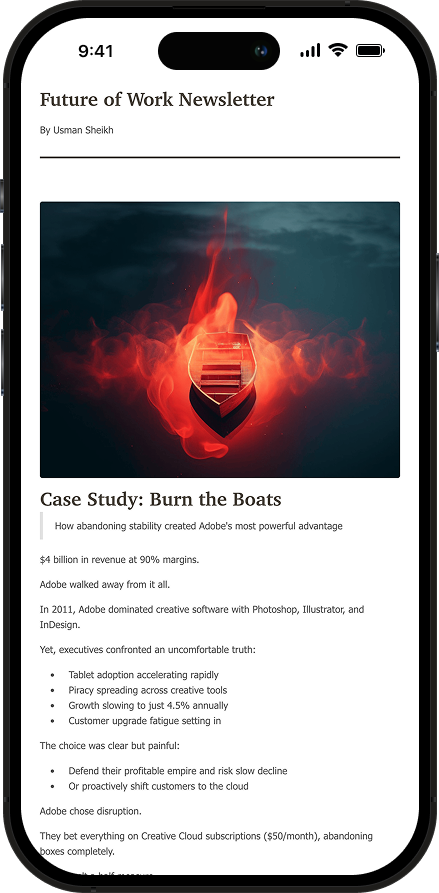4 May 2025
Case Study: Burn the Boats
How abandoning stability created Adobe's most powerful advantage
$4 billion in revenue at 90% margins.
Adobe walked away from it all.
In 2011, Adobe dominated creative software with Photoshop, Illustrator, and InDesign.
Yet, executives confronted an uncomfortable truth:
→ Tablet adoption accelerating rapidly
→ Piracy spreading across creative tools
→ Growth slowing to just 4.5% annually
→ Customer upgrade fatigue setting in
The choice was clear but painful:
→ Defend their profitable empire and risk slow decline
→ Or proactively shift customers to the cloud
Adobe chose disruption.
They bet everything on Creative Cloud subscriptions ($50/month), abandoning boxes completely.
This wasn't a half-measure.
They committed fully:
→ Announced Creative Cloud in 2011
→ Launched parallel offerings in 2012
→ Cut the cord entirely in 2013, ending perpetual licenses
Short-term consequences were severe:
→ Revenue dropped 8% almost immediately
→ Adobe's stock initially dipped significantly
→ Customers petitioned against the "rental model"
→ Analysts labeled it "strategic suicide"
The easy path would have been to reverse course at the first sign of trouble.
But leadership remained disciplined and transparent, communicating internally: "We either disrupt ourselves or competitors will."
They refocused investors on subscription growth and Annual Recurring Revenue (ARR), reframing the temporary revenue drop.
Within three years, the strategy proved visionary:
→ 2015: Revenue surpassed pre-transition levels
→ 2017: Growth accelerated to double digits
→ Customer base expanded beyond traditional segments
→ Recurring revenue reached 70% of total
By 2023, results spoke louder than early critics:
→ Revenue quadrupled to nearly $20 billion
→ Margins expanded beyond previous levels
→ Subscriber base grew to 37 million (3x past peak)
→ Creative Cloud became a massive ecosystem
The lesson: Real leadership requires willingly sacrificing a stable present for an uncertain but defensible future.
In the AI era, the Adobe story resonated with me louder than ever. Most large businesses face the same threats.
True disruption isn't glamorous. It's painful, messy, and intensely unpopular at first.
Comfort quietly accumulates debt. That debt is irrelevance.
Monday Mission:
→ Identify your most vulnerable profitable business
→ Calculate its runway before significant decline
→ Define one bold step to control your disruption
→ Get honest feedback from a peer
Great leaders don't perfect declining models. They disrupt them early, when it still feels unnecessary.
